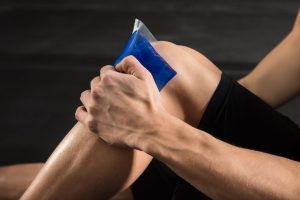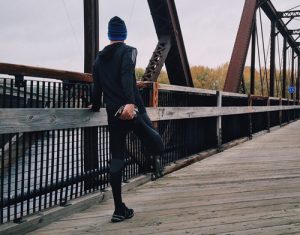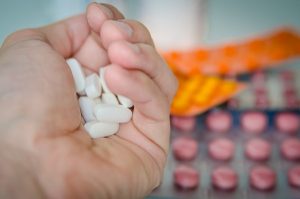HOME TREATMENTS
Using Ice & Heat
 During the first 72 hours of an acute injury, ice should be your modality of choice. Occasionally certain injuries will require the use of ice over an extended period of time. Application of heat after 72 hours is appropriate, but may still need to be alternated with ice application. Acute injuries will involve pain, swelling, heat and redness at or around the injured area. Using the P.R.I.C.E. formula during this phase will serve to help benefit the healing process and reduce pain.
During the first 72 hours of an acute injury, ice should be your modality of choice. Occasionally certain injuries will require the use of ice over an extended period of time. Application of heat after 72 hours is appropriate, but may still need to be alternated with ice application. Acute injuries will involve pain, swelling, heat and redness at or around the injured area. Using the P.R.I.C.E. formula during this phase will serve to help benefit the healing process and reduce pain.
- Protection of the injured joint
- Rest from aggravating activities
- Ice as outlined
- Compression (use of a brace or wrap)
- Elevation
Real Ice vs. frozen gel packs
Ice will cool the tissue quicker and penetrate deeper as opposed to gel packs, but both are acceptable forms of cryotherapy.
No early heat treatments
Although many patients state heat feels better than ice, the effects of early heat application will slow the healing by as much as 30 days. This occurs because heat increases: underlying hemorrhage, pain, swelling,
Warning
Do not exceed 20 minutes with ice or heat. Both can burn and blister the skin if left on too long. Using ice for more than 20 minutes can have the opposite effect and increase inflamation rather than reduce it.
Accepted ice application (times and frequency)
10- 20 minute maximums
10 minutes for: neck, elbow, wrist, hand, shin, ankle, foot
15 minutes for: midback, shoulder, knee
20 minutes for: lowback, pelvis, thigh
Frequency:
Minimum: 2-4 times per day
Maximum: hourly
Procedure:
Place ice on or around the injured area.
Ice massage in the form of bagged ice or frozen in paper cups use circular motions. Massage until area becomes numb and stop
Use compression wrap between ice applications
What should you use for pain if there’s no injury?
Start with ice. If no relief of pain, than switch to heat. If ice does not relieve pain or makes the pain worse use the heat. If heat aggravates pain, use ice. If you suspect a vascular problem, you should consult your physician before ice or heat is applied.
Exercising After An Injury
 Bed rest has been a standard protocol of the past for most all spinal and musculoskeletal conditions. Most recent research indicates this protocol should be STOPPED. It is now recognized that joint rest and bed rest for tissue injury will delay the healing process and cause osteoarthritis and loss of joint mobility.
Bed rest has been a standard protocol of the past for most all spinal and musculoskeletal conditions. Most recent research indicates this protocol should be STOPPED. It is now recognized that joint rest and bed rest for tissue injury will delay the healing process and cause osteoarthritis and loss of joint mobility.
Joint exercise
The area must be actively or passively exercised. This may be initiated in the early phase of inflammation. Research indicates that the effects of early movement speed healing, decrease scar tissue formation, decrease pain fiber formation and help restore normal ranges of motion.
Cardiovascular Exercises
Activity such as walking and biking, etc. will serve to increase oxygen in the tissues which aid healing and decreases pain sensitivity. Your injury or previous experience with exercise will determine your starting point. Some individual may need to begin exercise sessions of 2-3 minutes several times per day, increasing their personal stamina. For others, 10- 20 minutes per day is adequate. As always check with your healthcare professional before beginning any form of exercise.
Resistive Exercise
Weight bearing exercise during injury healing should follow these procedures:
Do not exercise within a painful range
Do exercise just below the range of pain
More is not better during the initial healing phase
No pain, no gain does not apply here
Short motions with light weights or resistive bands are appropriate
Non-Resistant Exercises
Non-Resistant Exercises should be performed during the first 3 weeks.
These specific, injury- related, range of motion exercise protocols can be issued following a chiropractic examination.
Taking Supplements
 Nutritional imbalances in the body can cause inflammation which leads to muscle and joint pain and other degenerative conditions. Supplements should be taken in conjunction with a proper diet. Decrease your intake of processed foods, grains and breads due to the effect of increased inflammation that they have on your body. Increase fruits and vegetables. Consume meats that primarily have a diet of greens. Certain supplements should be taken on a daily basis, others are condition specific and should be directed or supervised by your chiropractor or specialist for better outcomes.
Nutritional imbalances in the body can cause inflammation which leads to muscle and joint pain and other degenerative conditions. Supplements should be taken in conjunction with a proper diet. Decrease your intake of processed foods, grains and breads due to the effect of increased inflammation that they have on your body. Increase fruits and vegetables. Consume meats that primarily have a diet of greens. Certain supplements should be taken on a daily basis, others are condition specific and should be directed or supervised by your chiropractor or specialist for better outcomes.
How do I know if I have excessive inflammation in my body?
Abnormal fatigue
Overweight
Fibromyalgia
Aches & pains
Exercise is too stressful
Easily get cold & flu symptoms
Normal touch is painful
Our doctors of chiropractic can direct you to the supplements that are tested and researched and absorb properly by your body. Specific supplements may be recommended as determined by your condition.
If you have any questions about taking supplements please call our office: 330-674-0444
READY FOR AN APPOINTMENT?
HOURS
Monday: 7:00AM - 6:00PM
Tuesday: 12:00AM - 5:00PM
Wednesday: 7:00 AM - 6:00PM
Thursday: 8:00AM - 5:00PM
Friday: 7:00AM - 6:00PM
Saturday: 7:00AM - 11:00AM
Sunday: CLOSED
HOURS
Monday: 7:00AM - 6:00PM
Tuesday: 12:00AM - 5:00PM
Wednesday: 7:00 AM - 6:00PM
Thursday: 8:00AM - 5:00PM
Friday: 7:00AM - 6:00PM
Saturday: 7:00AM - 11:00AM
Sunday: CLOSED

1245 Glen Dr Millersburg, OH 44654
Phone: 330-674-0444
